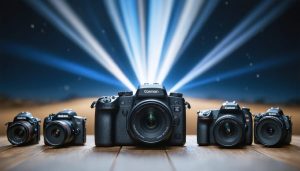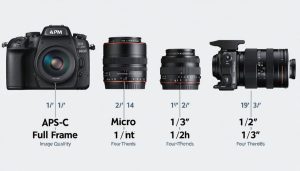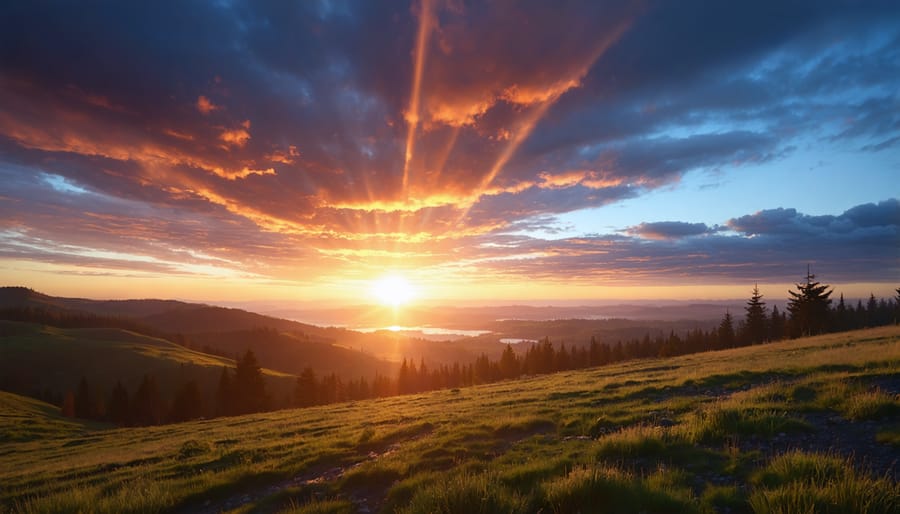
Picture a scene where brilliant sunlight streams through dark storm clouds, creating a dramatic contrast that challenges even the most advanced cameras. Dynamic range – the camera’s ability to capture both the brightest highlights and darkest shadows in a single shot – stands as one of photography’s most crucial yet misunderstood concepts.
From the subtle gradients of a sunset to the harsh contrasts of urban architecture, your camera’s dynamic range capabilities directly impact how faithfully it can reproduce what your eyes see. Modern digital cameras can typically capture 12-14 stops of dynamic range, yet human vision perceives around 20 stops, creating a fascinating gap between reality and digital reproduction.
Understanding dynamic range isn’t just about technical specifications – it’s about mastering the art of capturing life’s dramatic contrasts. Whether you’re shooting landscapes at golden hour or documenting street scenes in challenging lighting conditions, your grasp of dynamic range can mean the difference between a flat, uninspiring image and one that truly captures the depth and dimension of the moment.
For photographers navigating today’s digital landscape, dynamic range represents more than just a technical specification – it’s a creative tool that shapes how we interpret and capture the world around us. As camera technology continues to evolve, pushing the boundaries of what’s possible in both highlight and shadow detail, understanding dynamic range becomes increasingly essential for anyone serious about their craft.
This article will explore the intricacies of camera dynamic range, offering practical insights for photographers at every level who seek to master this fundamental aspect of digital imaging.
What Dynamic Range Really Means for Your Photos
The Science Behind Dynamic Range
At the heart of dynamic range lies the camera’s sensor, a sophisticated piece of technology that transforms light into digital information. When light hits the sensor, millions of photosites (also known as pixels) capture photons and convert them into electrical signals. These signals are then processed and translated into digital values that create the final image.
Think of each photosite as a bucket collecting raindrops of light. Some buckets might receive just a few drops (shadows), while others could be overwhelmed with water (highlights). The sensor’s ability to accurately record both extremes simultaneously determines its dynamic range capacity.
Modern camera sensors typically process this information in 12-14 bits per color channel, theoretically capable of capturing thousands of brightness levels. However, the actual dynamic range is limited by factors like electronic noise at low light levels and saturation points in bright areas.
The analog-to-digital conversion process is crucial here. When a photosite reaches its maximum capacity (highlights) or receives too little light (shadows), detail is lost. This is why we see pure white or black areas in photos where the scene’s brightness exceeds the sensor’s dynamic range capabilities.
Different sensor sizes and technologies handle this conversion differently. Larger sensors generally perform better because their photosites are bigger, allowing them to capture more light while maintaining better signal-to-noise ratios in darker areas.
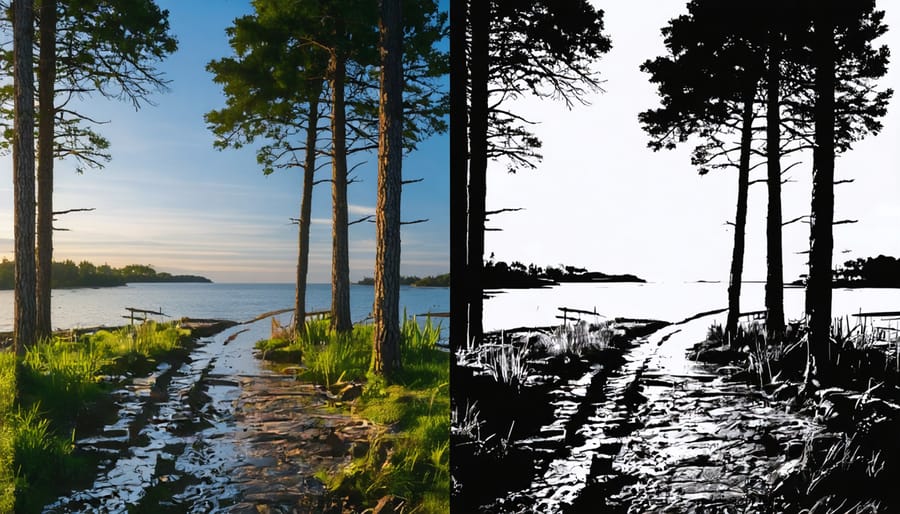
Stops of Light: Understanding Dynamic Range Measurement
In photography, dynamic range is measured in “stops” of light, where each stop represents a doubling or halving of light intensity. A camera capable of capturing 12 stops of dynamic range can theoretically handle a brightness ratio of 1:4096 (2¹²), from the darkest to brightest details in a scene.
Modern digital cameras typically offer between 12 and 14 stops of dynamic range, with high-end professional cameras pushing beyond 15 stops. To put this in perspective, the human eye can perceive approximately 20 stops of dynamic range in a single glance, adapting to see even more over time.
When measuring dynamic range, photographers often use standardized tests involving graduated gray cards or specialized targets. A common method is to photograph a scene with known brightness variations and analyze how many distinct tonal values the camera can capture before losing detail in shadows or highlights.
Understanding stop values is crucial for real-world photography. For instance, a sunny outdoor scene might have a dynamic range of 14 stops from deep shadows to bright highlights. If your camera only captures 12 stops, you’ll need to choose whether to preserve highlight or shadow detail, or use techniques like HDR photography to capture the full range.
Each stop increment represents a significant change in light-gathering capability. Moving from a camera with 12 stops to one with 13 stops means capturing twice as much dynamic range, potentially making the difference between losing and retaining crucial image details in challenging lighting conditions.
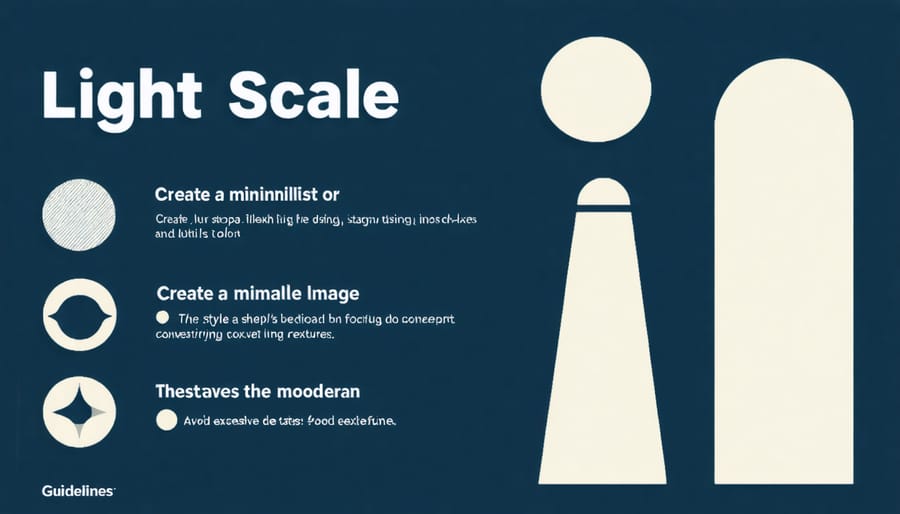
Modern Sensor Technology and Dynamic Range
How Different Sensor Types Handle Dynamic Range
Different sensors handle dynamic range in distinct ways, largely influenced by their physical characteristics. Camera sensor sizes play a crucial role in determining how well they can capture both highlights and shadows. Generally, larger sensors have bigger photosites (pixels), which can collect more light and handle a broader range of brightness levels more effectively.
Full-frame sensors typically offer the best dynamic range performance, with modern versions capable of capturing 14-15 stops of dynamic range. This is because their larger photosites can gather more light while generating less noise, particularly in shadow areas. When comparing different sensor types, we see that APS-C sensors usually manage 12-13 stops, while Micro Four Thirds sensors typically achieve 11-12 stops.
The sensor’s underlying technology also matters significantly. Back-illuminated (BSI) sensors, for instance, can capture more light than traditional front-illuminated sensors, potentially offering better dynamic range. Dual gain ISO technology, found in many modern cameras, helps maintain good dynamic range even at higher ISO settings.
Some manufacturers implement specialized technologies to enhance dynamic range. For example, Sony’s Dual ISO technology and Canon’s Dual Gain Output sensors are designed to optimize both shadow and highlight detail capture. These innovations help cameras better handle high-contrast scenes, making it easier for photographers to capture challenging lighting conditions without requiring extensive post-processing.
Recent Advances in Sensor Technology
Recent years have witnessed remarkable advancements in sensor technology, dramatically expanding the dynamic range capabilities of modern cameras. One of the most significant breakthroughs has been the development of dual-gain architecture sensors, which effectively capture both highlight and shadow detail simultaneously. This innovation, combined with improved sensor size impact, has pushed dynamic range capabilities beyond 14 stops in some professional cameras.
Stacked sensor designs have also revolutionized how cameras process light information. By incorporating dedicated processing layers beneath the light-capturing surface, these sensors can read data more efficiently and reduce noise in shadow areas, resulting in cleaner images across the entire dynamic range.
The introduction of backside-illuminated (BSI) sensors has been another game-changer. By moving the circuitry to the back of the sensor, more light reaches the photosites, improving low-light performance and expanding the camera’s ability to capture detail in both bright and dark areas.
Manufacturers have also made significant strides in pixel design, developing dual-native ISO technology that allows sensors to operate at two different sensitivity levels without compromising image quality. This advancement particularly benefits videographers who need to maintain excellent dynamic range while shooting in challenging lighting conditions.
AI-powered processing has further enhanced dynamic range capabilities through intelligent scene analysis and exposure optimization. These systems can now recognize complex lighting scenarios and automatically adjust sensor parameters to capture the maximum possible detail across the entire brightness spectrum.
Practical Applications and Real-World Benefits
Landscape Photography: Capturing Sky and Shadow
Landscape photography presents some of the most challenging scenarios for managing dynamic range, particularly during golden and blue hours when the contrast between bright skies and shadowed foregrounds can be extreme. Understanding how to work with these real-world image quality differences is crucial for capturing stunning landscapes.
Consider a typical sunset scene: the sky blazes with vibrant oranges and reds while the foreground terrain falls into deep shadow. Your camera’s sensor must simultaneously capture detail in both the brilliant highlights of the clouds and the subtle textures in the darkened landscape. This is where dynamic range becomes a make-or-break factor in your photography.
Modern cameras typically handle about 12-14 stops of dynamic range, but many landscape scenes can exceed 15 stops of contrast. To overcome this limitation, photographers often employ techniques like bracketing (taking multiple exposures at different settings) or using graduated neutral density filters to balance exposure across the frame.
The challenge becomes particularly apparent in scenes with reflective elements, such as mountain lakes or ocean waves, where you’re dealing with both direct and reflected light. The key is to recognize these high-contrast situations early and plan your approach accordingly, whether that means waiting for more favorable lighting conditions or preparing to blend multiple exposures in post-processing.
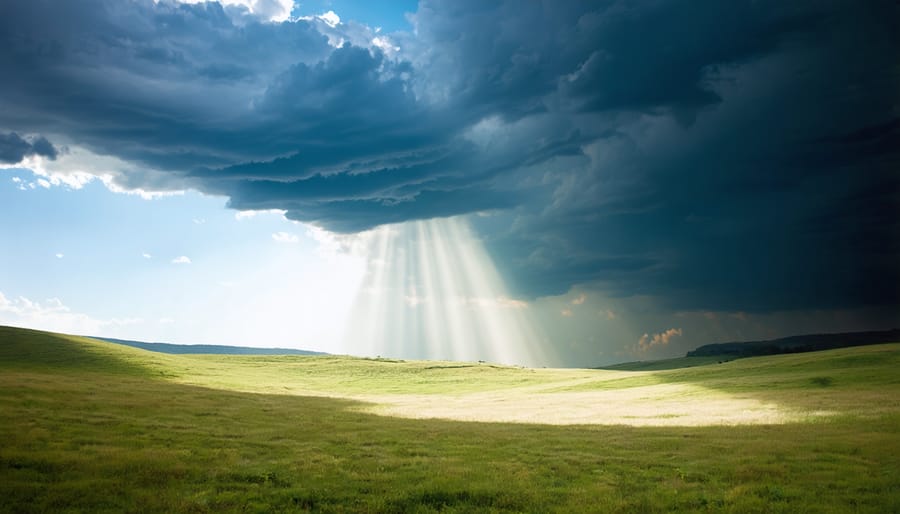
Indoor and Low-Light Photography
Enhanced dynamic range becomes particularly valuable when shooting in challenging indoor environments or low-light conditions. These situations often present extreme contrasts between bright and dark areas, such as sunlight streaming through windows into a dimly lit room, or artificial lighting creating harsh shadows in an indoor event.
A camera with superior dynamic range excels in these scenarios by capturing both the subtle details in shadows and the nuanced highlights without losing information. For instance, when photographing a candlelit dinner, you can maintain the warm ambiance of the candles while still revealing the textures and colors of the food and dining setup.
This capability is especially crucial for wedding photographers shooting in churches, event photographers working in poorly lit venues, or architectural photographers capturing interior spaces. Rather than choosing between blown-out windows or pitch-black interiors, photographers can capture both in a single frame, significantly reducing the need for complex lighting setups or multiple exposure blending in post-processing.
To maximize your camera’s dynamic range in these situations, consider shooting in RAW format, which preserves more detail in both highlights and shadows. Additionally, using your camera’s histogram as a guide can help ensure you’re not clipping important details at either end of the exposure range. Some photographers also employ techniques like exposing for highlights and recovering shadow detail later, which becomes more effective with cameras offering greater dynamic range.
Maximizing Your Camera’s Dynamic Range
Camera Settings That Matter
To maximize your camera’s dynamic range potential, several key settings deserve your attention. First and foremost is ISO selection – keeping it as low as possible helps preserve both highlight and shadow detail. While modern sensor capabilities have improved dramatically, shooting at base ISO (usually 100 or 200) will always yield the best dynamic range performance.
Your camera’s metering mode also plays a crucial role. Matrix or evaluative metering works well for most scenes, but in high-contrast situations, spot metering can help you precisely measure the brightest and darkest areas. This information allows you to make informed exposure decisions.
RAW format is non-negotiable when dynamic range is a priority. Unlike JPEG, RAW files retain all the data captured by your sensor, giving you considerable flexibility during post-processing to recover highlights and shadows.
Many cameras offer specific dynamic range optimization features, like Canon’s Highlight Tone Priority or Nikon’s Active D-Lighting. While these can be helpful, they’re most effective when used judiciously and in conjunction with proper exposure techniques.
Speaking of exposure, the “expose to the right” (ETTR) technique can maximize dynamic range by pushing the histogram as far right as possible without clipping highlights. This takes advantage of the sensor’s natural ability to capture more information in brighter areas.
Finally, consider using bracketing for challenging scenes. Taking multiple exposures at different settings ensures you capture the full range of tones, which can be combined later if needed.
Post-Processing Techniques
Post-processing has become an essential tool for managing and extending dynamic range in digital photography. One of the most powerful techniques is HDR (High Dynamic Range) merging, where multiple exposures of the same scene are combined to capture detail in both highlights and shadows. When working with RAW files, the exposure slider in your editing software becomes your best friend, allowing you to recover seemingly lost details in both bright and dark areas.
The shadows and highlights sliders are particularly useful for fine-tuning dynamic range. Start by bringing down highlights to recover detail in bright areas like clouds, then lift shadows to reveal information in darker regions. Remember to use these adjustments judiciously – pushing them too far can lead to unnatural-looking results and introduce unwanted noise.
Local adjustments through masks or graduated filters can help balance exposure across different parts of your image. For instance, you might darken an overly bright sky while maintaining proper exposure in the foreground. The tone curve is another powerful tool, offering precise control over contrast and brightness in specific tonal ranges.
For single-exposure photos, techniques like exposure blending can help simulate greater dynamic range. This involves creating multiple versions of the same RAW file at different exposure levels and combining them selectively using layer masks in your editing software. When applying these techniques, always aim for natural-looking results that maintain the original feeling of the scene.
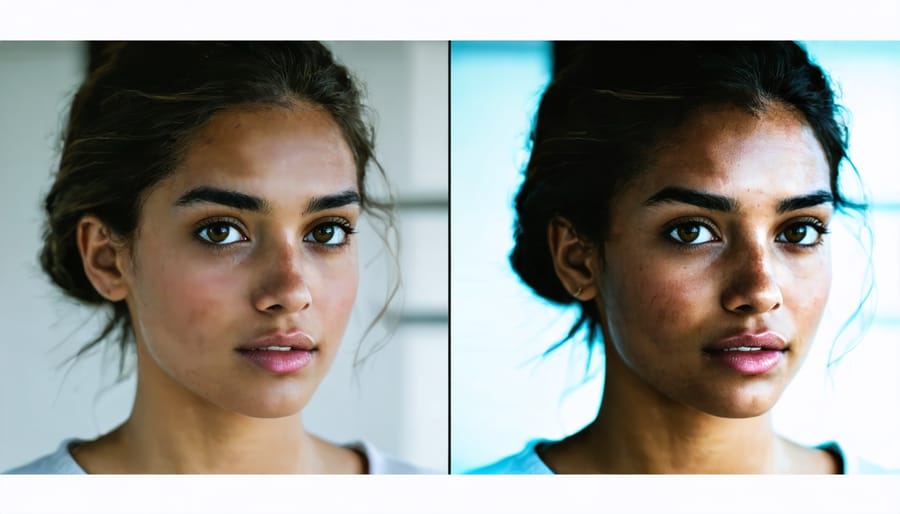
Dynamic range remains one of the most crucial aspects of modern digital photography, fundamentally shaping how we capture and preserve the world around us. As we’ve explored throughout this article, understanding and mastering dynamic range can be the difference between a good photograph and an exceptional one that truly captures the scene as our eyes perceive it.
The evolution of camera technology has brought us sensors capable of capturing increasingly wider dynamic ranges, enabling photographers to tackle challenging lighting conditions that were once considered impossible to photograph effectively. From shooting in harsh midday sun to capturing the subtle details in both shadows and highlights during golden hour, this technical capability has expanded creative possibilities enormously.
For photographers at any level, the practical implications of dynamic range knowledge are significant. Whether you’re adjusting exposure settings in-camera, choosing between different camera models, or processing RAW files in post-production, understanding dynamic range helps you make informed decisions that improve your final images.
Remember that while having a camera with excellent dynamic range is valuable, it’s equally important to develop the skills to work within your equipment’s limitations. Techniques like exposure bracketing, using graduated neutral density filters, and careful composition can help you overcome dynamic range constraints when necessary.
As camera technology continues to advance, we can expect to see even more improvements in dynamic range capabilities. However, the fundamental principles we’ve discussed will remain relevant, forming the backbone of how we approach challenging lighting situations and create compelling images that reflect our creative vision.
Understanding dynamic range isn’t just about technical specifications – it’s about expanding your creative possibilities and capturing images that more closely match what you envision.


